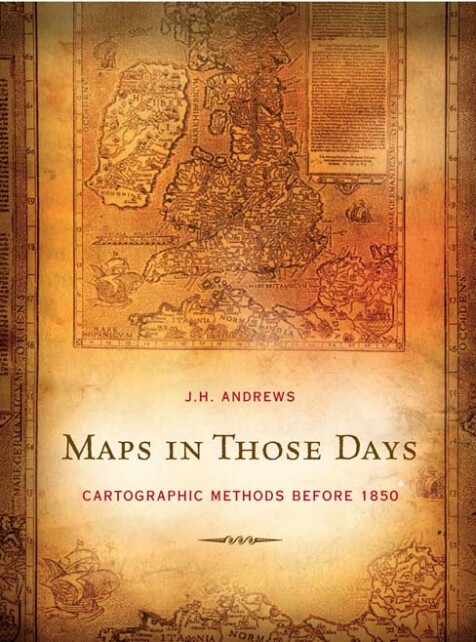Maps in those days
Cartographic methods before 1850
J.H. Andrews
‘Big, solid work ... readable as well as reliable ... fascinating and beautifully illustrated’, L.R.N. Ashley, Bibliothèque d’Humanisme et Renaissance.
‘This book provides a much-needed overview of the techniques of surveying and mapping employed by Europeans from the sixteenth century until the early twentieth century, when aerial photography revolutionised base mapping … This summa of [Andrews’] rich and extensive knowledge should be read by any scholar interested in using old maps as evidentiary sources, as well as by all map historians … [it] provides a wealth of knowledge that will inform future research … the book should be read by everyone interested in old maps', Matthew H. Edney, EHR (Oct. 2011).
‘Maps in those days, by John Andrews, a former associate professor in the Geography Department at Trinity College Dublin, is an extremely significant volume discussing the history of cartography. The publisher has pulled out all the stops in making this book as visually attractive as possible, with copious maps and illustrations which not only further illuminate the text, but many of which are visual wonders in their own right … for those interested in cartography in general, Maps in those days is a vitally important book, and a must for all reference and research libraries', Brendan Scott, Breifne journal (2009-10).
‘A fascinating and instructive account of the processes involved in the preparation of general maps before the appearance of photographic aids in the mid-nineteenth century … this wide-ranging work, nicely presented as “a mixture of historical narrative and classroom-style exposition”, abounds with details about the development of map making prior to 1850 … Another strength of the book is the nearly 250 maps and illustrations, which are presented in full or half-page black and white reproductions. It is obvious that they were thoughtfully selected to forward the narrative rather than just enhance the book … Maps in Those Days fills a major void in the literature of the history of cartography by providing a single-volume scholarly reference work on the basic map-making processes. It is strongly recommended for anyone interested in cartography and its history', Ralph E. Ehrenberg, Imago Mundi (2011).
‘John Andrews is the authoritative historian of the mapping of Ireland … This year, Andrews has launched two new books. One is his most ambitious yet: the profusely illustrated and exhaustively structured, 580-page Maps in Those Days. Remarkably, considering the burgeoning literature of recent years, it’s the first full study of how maps were constructed before the advent of photography’, Mic Moroney, Irish Arts Review (Summer 2009).
‘This is a magnificent study of maps and map-making (and of course geographical knowledge and discoveries) from earliest times until the mid 19th century, generously illustrated with exceptionally good reproductions … altogether a book that will surely survive as a classic', Books Ireland (September 2009).
‘There is no doubt that Professor Andrews knows his way about when it comes to maps and the collections of old maps held in Ireland and Britain. His vast research experience is mirrored in this massive, well-illustrated volume showing everything you need to know about how maps were made before the invention of photography … there is no denying the passion and learning that imbues [t]his comprehensive compilation', Timothy O'Neill, Books Ireland (December 2009).
‘Maps are power. They are also magic - the paths of adventure, the code to breaking secrets, to understanding a landscape. John Andrews is a practical geographer, but he is also a philosopher possessed of curiosity and imagination. Within the covers of this scholarly volume is mystery defined. It is a history and also a romance. If there is a complete book about cartography as a science and as a specifically European art developing during the Renaissance and Enlightenment, this is it', Eileen Battersby, “The Best Non-Fiction: Eileen Battersby’s Picks of the Year”, Irish Times (December 2009).

